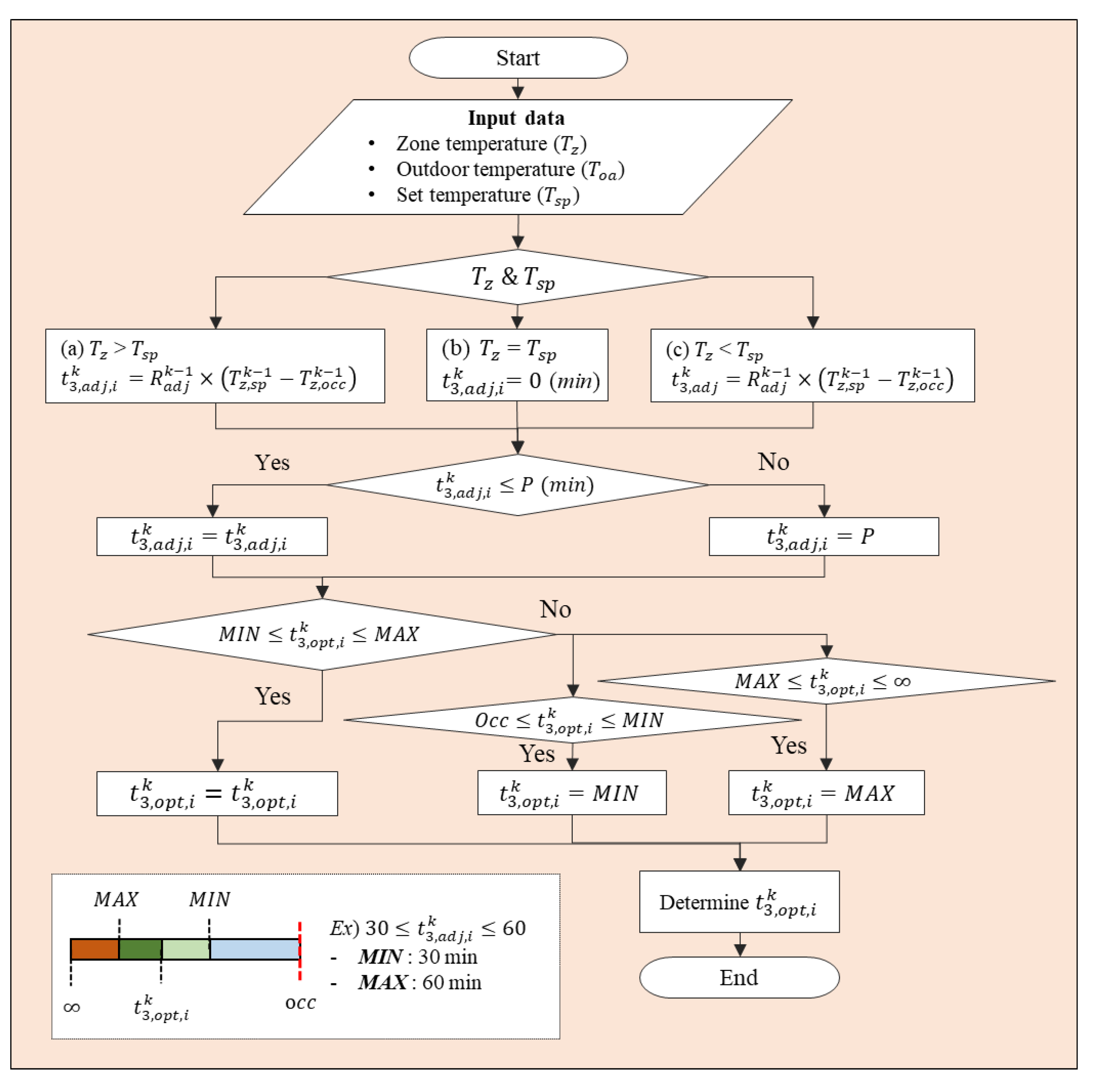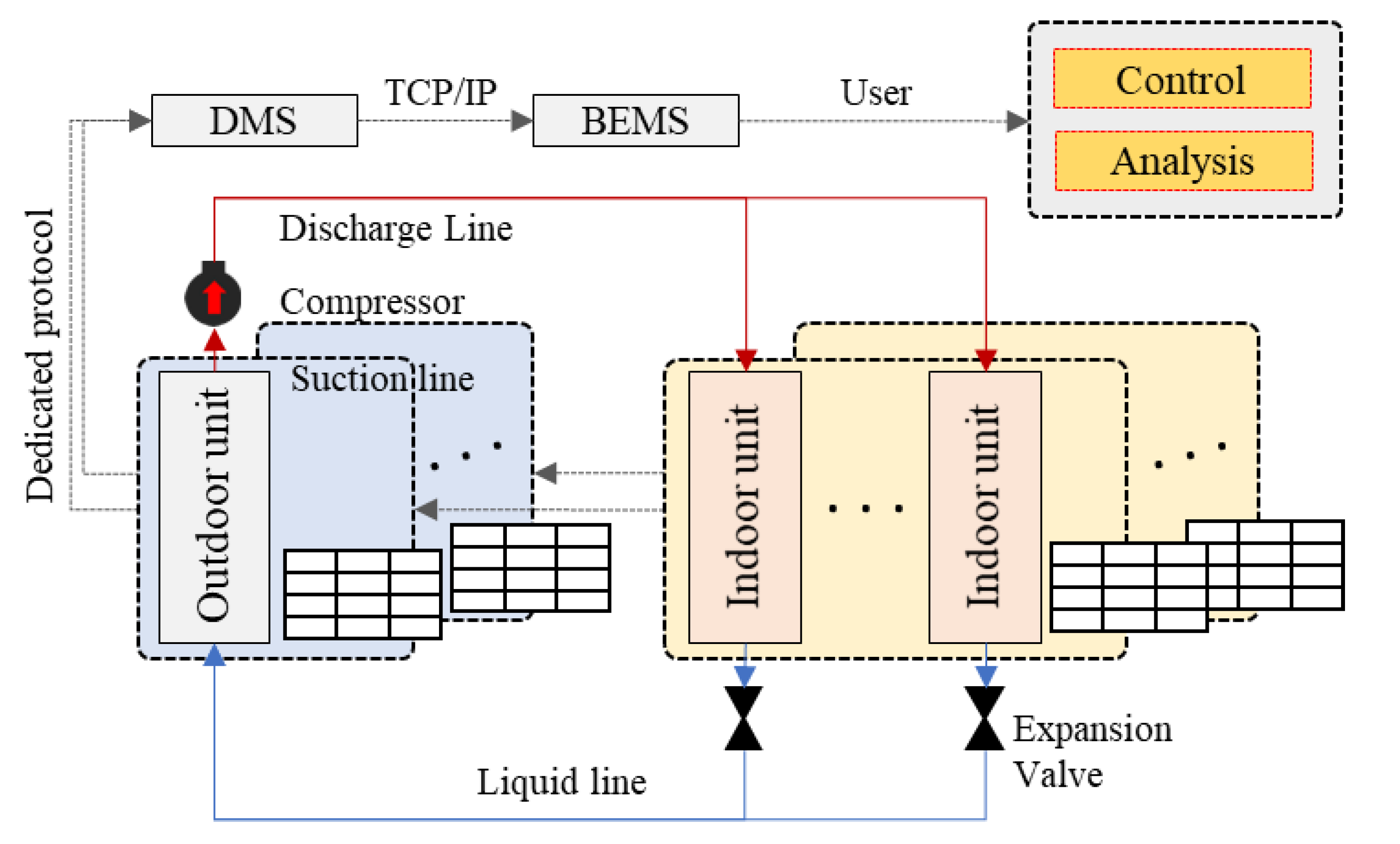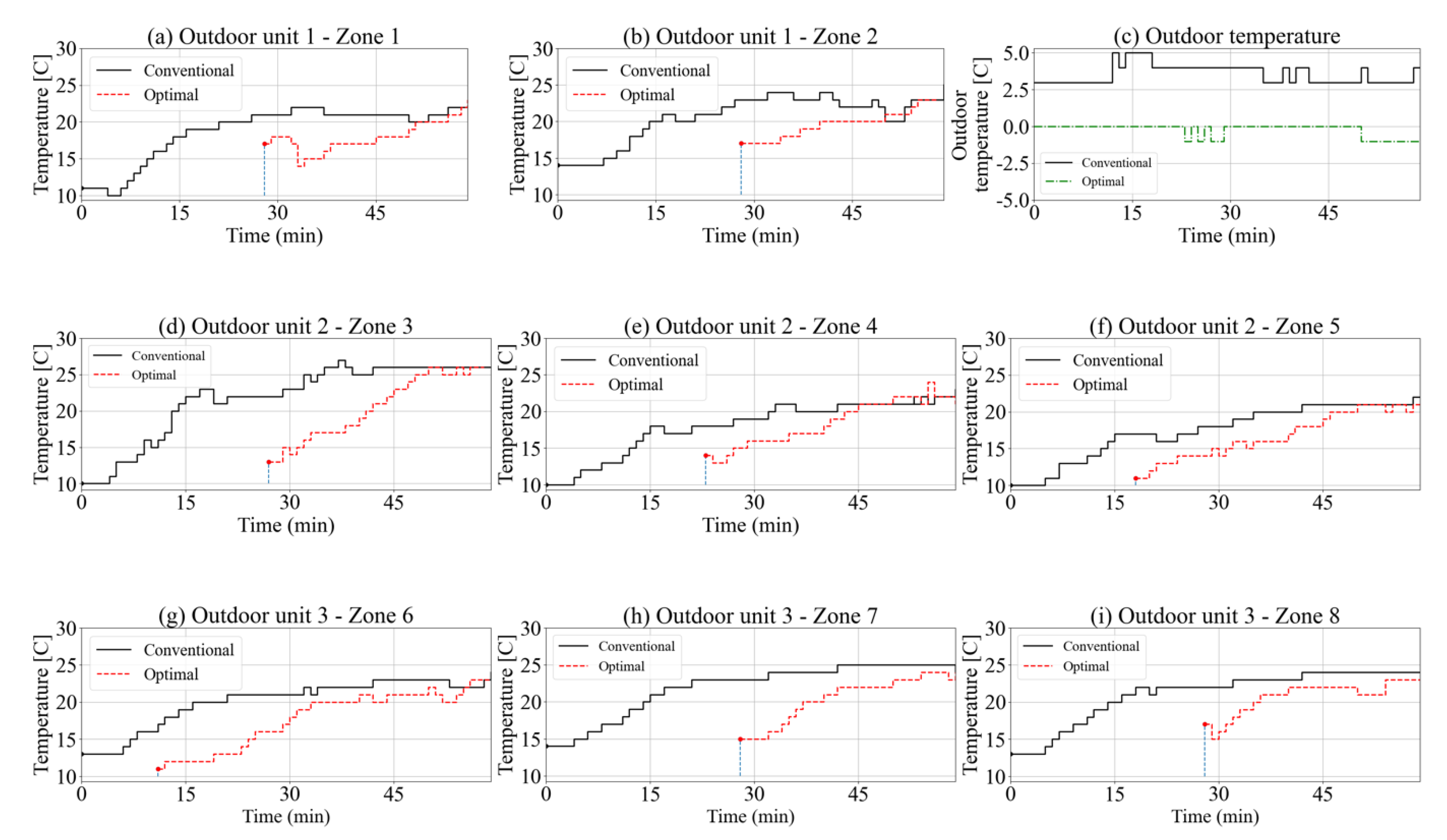Development of an Optimal Start Control Strategy for a Variable Refrigerant Flow (VRF) System
Abstract
1. Introduction
2. Method
2.1. Model 1
2.2. Model 2
2.3. Model 3
2.4. Optimal Start Rules
2.5. Energy Savings
3. System Specification and Test Conditions
4. Results and Discussion
4.1. Results of Model Prediction Accuracy
4.2. Results of the Proposed Optimal Strategy
5. Conclusions
Author Contributions
Funding
Data Availability Statement
Conflicts of Interest
Nomenclature
| Coefficient at which the zone heats up after equipment start-up | |
| Adjustment of heating capacity | |
| Coefficient of temperature response | |
| Coefficient of heating transfer | |
| Energy saving (%) | |
| Energy usage (kWh) | |
| Min-operating time (min) | |
| Max-operating time (min) | |
| Maximum adjustment time (min) | |
| Adjustment weight (min/) | |
| Time (min) | |
| Temperature () | |
| Subscripts | |
| Adjust | |
| Conventional | |
| Initial | |
| Zone number | |
| Day number | |
| Occupancy time | |
| Optimal | |
| Outdoor air | |
| Rated | |
| Set point (set) | |
References
- Burnard, K.; Bhattacharya, S. Power Generation from Coal-Ongoing Developments and Outlooks; International Energy Agency: Paris, France, 2011. [Google Scholar]
- Kapusta, K.; Stańczyk, K. Pollution of water during underground coal gasification of hard coal and lignite. Fuel 2011, 90, 1927–1934. [Google Scholar] [CrossRef]
- Liu, M.; Claridge, D.E.; Turner, W.D. Continuous commissioningSM of building energy systems. J. Sol. Energy Eng. 2003, 125, 275–281. [Google Scholar] [CrossRef]
- Mills, E. Building commissioning: A golden opportunity for reducing energy costs and greenhouse gas emissions in the United States. Energy Effic. 2011, 4, 145–173. [Google Scholar] [CrossRef]
- Sun, Y.; Wang, S.; Huang, G. Model-based optimal start control strategy for multi-chiller plants in commercial buildings. Build. Serv. Eng. Res. Technol. 2010, 31, 113–129. [Google Scholar]
- Yang, I.-H. Development of an artificial neural network model to predict the optimal pre-cooling time in office buildings. J. Asian Arch. Build. Eng. 2010, 9, 539–546. [Google Scholar] [CrossRef]
- Xu, B.; Zhou, S.; Hu, W. An intermittent heating strategy by predicting warm-up time for office buildings in Beijing. Energy Build. 2017, 155, 35–42. [Google Scholar] [CrossRef]
- Gayeski, N.T.; Armstrong, P.R.; Norford, L.K. Predictive pre-cooling of thermo-active building systems with low-lift chillers. HVAC&R Res. 2012, 18, 1–16. [Google Scholar]
- Motegi, N.; Piette, M.A.; Watson, D.S.; Kiliccote, S.; Xu, P. Introduction to Commercial Building Control Strategies and Techniques for Demand Response—Appendices; No. LBNL-59975; Lawrence Berkeley National Laboratory (LBNL): Berkeley, CA, USA, 2007. [Google Scholar]
- Zhao, P.; Suryanarayanan, S.; Simoes, M.G. An energy management system for building structures using a multi-agent decision-making control methodology. IEEE Trans. Ind. Appl. 2013, 49, 322–330. [Google Scholar] [CrossRef]
- Yin, R.; Xu, P.; Piette, M.A.; Kiliccote, S. Study on Auto-DR and pre-cooling of commercial buildings with thermal mass in California. Energy Build. 2010, 42, 967–975. [Google Scholar] [CrossRef]
- Prívara, S.; Široký, J.; Ferkl, L.; Cigler, J. Model predictive control of a building heating system: The first experience. Energy Build. 2011, 43, 564–572. [Google Scholar] [CrossRef]
- Alcalá, R.; Benítez, J.M.; Casillas, J.; Cordón, O.; Pérez, R. Fuzzy control of HVAC systems optimized by genetic algorithms. Appl. Intell. 2003, 18, 155–177. [Google Scholar] [CrossRef]
- Hilliard, T.; Swan, L.; Qin, Z. Experimental implementation of whole building MPC with zone based thermal comfort adjustments. Build. Environ. 2017, 125, 326–338. [Google Scholar] [CrossRef]
- Kummert, M.; André, P.; Nicolas, J. Building and HVAC optimal control simulation. Application to an office building. In Proceedings of the Third International Symposium on HVAC; Tsinghua University: Beijing, China; Hong Kong Polytechnical University: Hong Kong, China, 1999; pp. 857–868. [Google Scholar]
- Chen, C.; Wang, J.; Heo, Y.; Kishore, S. MPC-based appliance scheduling for residential building energy management controller. IEEE Trans. Smart Grid 2013, 4, 1401–1410. [Google Scholar] [CrossRef]
- Lim, B.; Hijazi, H.; Thiébaux, S.; Briel, M.V.D. Online HVAC-aware occupancy scheduling with adaptive temperature control. In Principles and Practice of Constraint Programming; Springer International Publishing: New York, NY, USA, 2016; Volume 9892, pp. 683–700. [Google Scholar]
- Xu, P.; Haves, P.; Piette, M.A.; Braun, J. Peak Demand Reduction from Pre-Cooling with Zone Temperature Reset in an Office Building; Lawrence Berkeley National Laboratory: Berkeley, CA, USA, 2004. [Google Scholar]
- Nikovski, D.; Xu, J.; Nonaka, M. A method for computing optimal set-point schedules for HVAC systems. In Proceedings of the 11th REHVA World Congress CLIMA, Prague, Czech Republic, 16–19 June 2013. [Google Scholar]
- Afram, A.; Janabi-Sharifi, F. Black-box modeling of residential HVAC system and comparison of gray-box and black-box modeling methods. Energy Build. 2015, 94, 121–149. [Google Scholar] [CrossRef]
- Muratori, M.; Marano, V.; Sioshansi, R.; Rizzoni, G. Energy consumption of residential HVAC systems: A simple physically-based model. In Proceedings of the 2012 IEEE Power and Energy Society General Meeting, San Diego, CA, USA, 22–26 July 2012; Institute of Electrical and Electronics Engineers (IEEE): New York, NY, USA, 2012; pp. 1–8. [Google Scholar]
- Tang, R.; Wang, S.; Shan, K.; Cheung, H. Optimal control strategy of central air-conditioning systems of buildings at morning start period for enhanced energy efficiency and peak demand limiting. Energy 2018, 151, 771–781. [Google Scholar] [CrossRef]
- Park, B.R.; Yang, Y.K.; Hong, J.; Lee, J.H.; Moon, J.W. Development of an energy cost prediction model for a VRF heating system. Appl. Therm. Eng. 2018, 140, 476–486. [Google Scholar] [CrossRef]
- Liu, J.; Hu, Y.; Chen, H.; Wang, J.; Li, G.; Hu, W. A refrigerant charge fault detection method for variable refrigerant flow (VRF) air-conditioning systems. Appl. Therm. Eng. 2016, 107, 284–293. [Google Scholar] [CrossRef]
- Perez, K.X.; Baldea, M.; Edgar, T.F. Integrated HVAC management and optimal scheduling of smart appliances for community peak load reduction. Energy Build. 2016, 123, 34–40. [Google Scholar] [CrossRef]
- Mossolly, M.; Ghali, K.; Ghaddar, N. Optimal control strategy for a multi-zone air conditioning system using a genetic algorithm. Energy 2009, 34, 58–66. [Google Scholar] [CrossRef]
- Zajic, I.; Larkowski, T.; Sumislawska, M.; Burnham, K.; Hill, D. Modelling of an air handling unit: A Hammerstein-bilinear model identification approach. In Proceedings of the 2011 21st International Conference on Systems Engineering, Las Vegas, NV, USA, 16–18 August 2011; Institute of Electrical and Electronics Engineers (IEEE): New York, NY, USA, 2011; pp. 59–63. [Google Scholar]
- Hilliard, T.; Swan, L. A tool for evaluating the performance of simplified models for predictive control applications. In Proceedings of the 15th IBPSA Conference, San Francisco, CA, USA, 7–9 August 2017; pp. 672–681. [Google Scholar]
- Moon, J.W.; Yang, Y.K.; Choi, Y.J.; Lee, K.-H.; Kim, Y.-S.; Park, B.R. Development of a control algorithm aiming at cost-effective operation of a VRF heating system. Appl. Therm. Eng. 2019, 149, 1522–1531. [Google Scholar] [CrossRef]
- Ye, H.; Long, L.; Zhang, H.; Gao, Y. The energy saving index and the performance evaluation of thermochromic windows in passive buildings. Renew. Energy 2014, 66, 215–221. [Google Scholar] [CrossRef]
- Bakar, N.N.A.; Hassan, M.Y.; Abdullah, H.; Rahman, H.A.; Abdoullah, M.P.; Hussin, F.; Bandi, M. Energy efficiency index as an indicator for measuring building energy performance: A review. Renew. Sustain. Energy Rev. 2015, 44, 1–11. [Google Scholar] [CrossRef]








| Purpose | Periods | |
|---|---|---|
| Existing data | The comparison of prediction performance among the models | 2nd week of July 2019 2nd week of January 2019 |
| Experiments | Validation of the optimal start strategy performance | 3rd week of January 2020 |
| Outdoor Units | Outdoor Unit Capacity (kW) | Zone Number | Indoor Unit Capacity (kW) | ||
|---|---|---|---|---|---|
| Heating | Cooling | Heating | Cooling | ||
| 1 | 84.9 | 75.4 | 1 | 22 | 20 |
| 2 | 22 | 20 | |||
| 2 | 84.9 | 75.4 | 3 | 14.5 | 13 |
| 4 | 32.6 | 29 | |||
| 5 | 32.6 | 29 | |||
| 3 | 104.4 | 92.8 | 6 | 22 | 20 |
| 7 | 22 | 20 | |||
| 8 | 22 | 20 | |||
| Outdoor Units | 1 | 2 | 3 | ||||||
|---|---|---|---|---|---|---|---|---|---|
| Zone | 1 | 2 | 3 | 4 | 5 | 6 | 7 | 8 | |
| Heating Capacity (kW) | 22 | 22 | 14.5 | 32.6 | 32.6 | 22 | 22 | 22 | |
| Day 1 | Tz,init | 17 | 17 | 10 | 11 | 8 | 10 | 10 | 10 |
| Tz,occ | 22 | 22 | 24 | 21 | 21 | 20 | 23 | 22 | |
| Toa | −3 | ||||||||
| 8:30 | 8:30 | 8:22 | 8:16 | 8:10 | 8:13 | 8:19 | 8:25 | ||
| Day 2 | Tz,init | 10 | 13 | 13 | 12 | 8 | 10 | 12 | 13 |
| Tz,occ | 23 | 24 | 26 | 23 | 22 | 23 | 25 | 26 | |
| Toa | 0 | ||||||||
| 8:30 | 8:30 | 8:09 | 8:12 | 8:02 | 8:00 | 8:09 | 8:09 | ||
| Day 3 | Tz,init | 9 | 12 | 15 | 12 | 8 | 10 | 12 | 15 |
| Tz,occ | 24 | 23 | 24 | 21 | 22 | 23 | 25 | 25 | |
| Toa | −2 | ||||||||
| 8:09 | 8:26 | 8:30 | 8:18 | 8:00 | 8:17 | 8:28 | 8:30 | ||
| Day 4 | Tz,init | 14 | 13 | 12 | 14 | 15 | 11 | 15 | 14 |
| Tz,occ | 24 | 25 | 25 | 24 | 24 | 24 | 23 | 24 | |
| Toa | −1 | ||||||||
| 8:19 | 8:24 | 8:01 | 8:18 | 8:09 | 8:09 | 8:29 | 8:29 | ||
| Day 5 | Tz,init | 17 | 17 | 13 | 14 | 11 | 11 | 16 | 17 |
| Tz,occ | 23 | 23 | 26 | 21 | 21 | 23 | 24 | 23 | |
| Toa | −1 | ||||||||
| 8:28 | 8:28 | 8:27 | 8:23 | 8:18 | 8:11 | 8:28 | 8:28 | ||
| Energy Saving (%) | Outdoor Unit 1 | Outdoor Unit 2 | Outdoor Unit 3 | Average |
|---|---|---|---|---|
| Day 1 | 50.0% | 24.4% | 31.6% | 35.3% |
| Day 2 | 50.0% | 10.9% | 10.0% | 23.6% |
| Day 3 | 32.2% | 21.4% | 41.7% | 31.8% |
| Day 4 | 33.3% | 12.5% | 16.9% | 20.9% |
| Day 5 | 49.0% | 36.1% | 37.5% | 40.9% |
| Average | 42.9% | 21.1% | 27.5% | 30.5% |
Publisher’s Note: MDPI stays neutral with regard to jurisdictional claims in published maps and institutional affiliations. |
© 2021 by the authors. Licensee MDPI, Basel, Switzerland. This article is an open access article distributed under the terms and conditions of the Creative Commons Attribution (CC BY) license (http://creativecommons.org/licenses/by/4.0/).
Share and Cite
Lee, Y.; Kim, W. Development of an Optimal Start Control Strategy for a Variable Refrigerant Flow (VRF) System. Energies 2021, 14, 271. https://doi.org/10.3390/en14020271
Lee Y, Kim W. Development of an Optimal Start Control Strategy for a Variable Refrigerant Flow (VRF) System. Energies. 2021; 14(2):271. https://doi.org/10.3390/en14020271
Chicago/Turabian StyleLee, Yusung, and Woohyun Kim. 2021. "Development of an Optimal Start Control Strategy for a Variable Refrigerant Flow (VRF) System" Energies 14, no. 2: 271. https://doi.org/10.3390/en14020271
APA StyleLee, Y., & Kim, W. (2021). Development of an Optimal Start Control Strategy for a Variable Refrigerant Flow (VRF) System. Energies, 14(2), 271. https://doi.org/10.3390/en14020271





